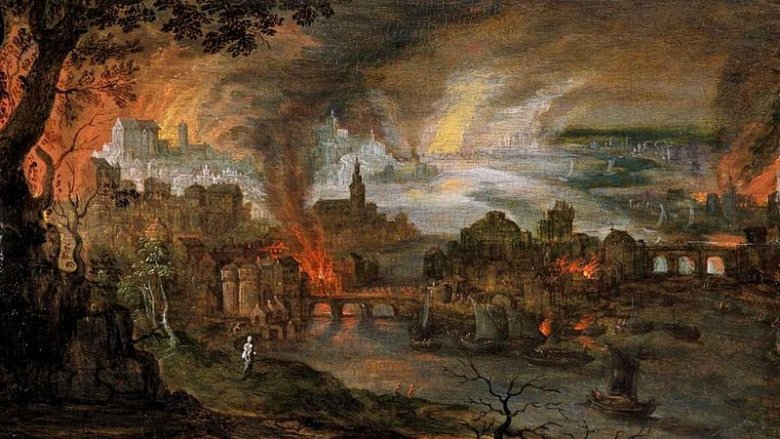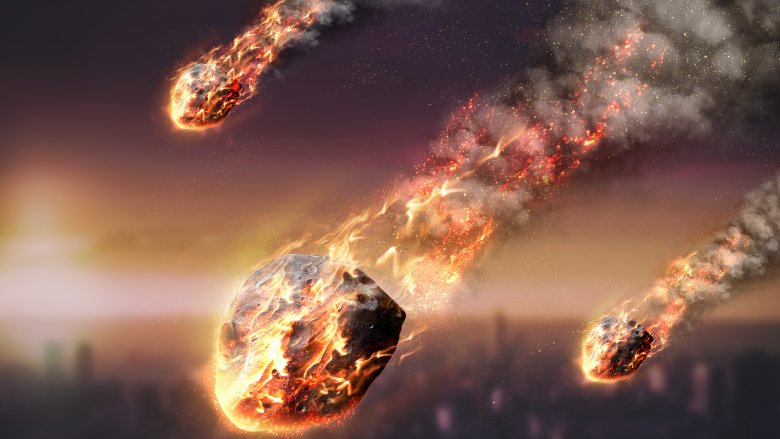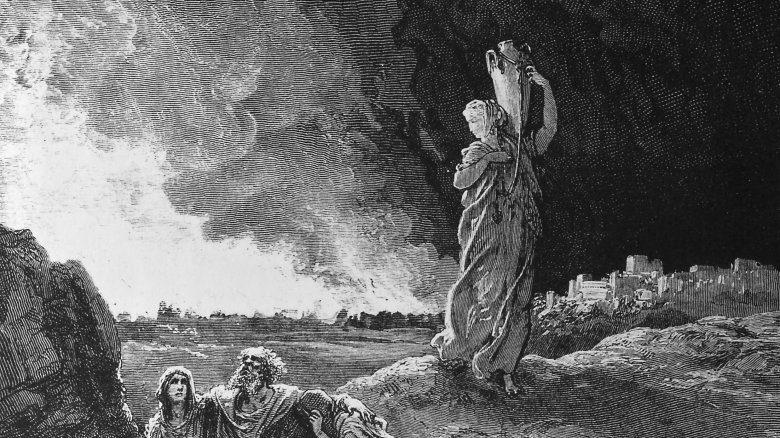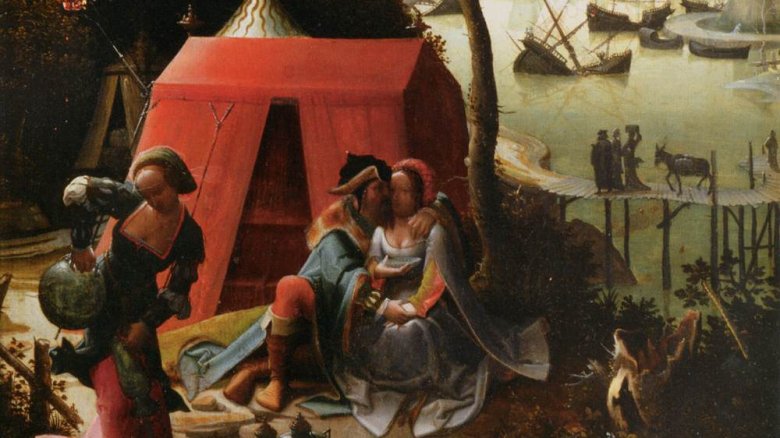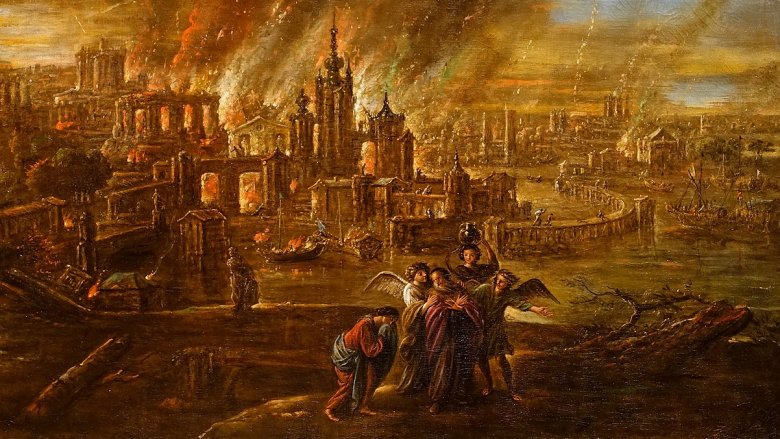The Untold Truth Of Sodom And Gomorrah
Las Vegas may like to style itself as "sin city," but there are only two cities in world history that were so sinful God had to actually explode them with fire. Sodom and Gomorrah and their fiery fate crop up in the Book of Genesis in the Old Testament, in the Torah, and in the Quran. However, you probably know them best from Sodom's historical association with homosexuality and hardline religious warnings circa 2013 that America would suffer the exact same fate the moment the Supreme Court allowed gay marriage, a prophecy that's up there with "Betamax is the future of home entertainment" in the accuracy stakes.
But even without the allure of glorious sodomy, Sodom and Gomorrah have cast a long shadow over the Western imagination. Yet how much does the average dude or dudette on the street actually know about these two long-dead cities and their unlucky inhabitants? Like, did they even exist, or are they just beautiful myths? The truth is even more complicated than you probably think.
There were three whole other cities we forgot about
Sodom and Gomorrah are like Batman and Robin, or Superman and "disappointing Zack Snyder movies" — you're so used to hearing them together that one without the other sounds weird. Yet this cozy linguistic partnership is as misleading as referring to The Beatles as just "John and Paul." If Sodom and Gomorrah were the main songwriters, their band was something called the Cities of the Plain, a collection of five great cities that sat along the Jordan River in Biblical times. And you better believe this ancient city supergroup had their own George and Ringo (and some other guy).
The three forgotten cities aren't just background details. Although they appear in the story of Lot far less than Sodom or Gomorrah, they have their own names and everything. Deuteronomy 29:22-23 identifies two of the other cities as Admah and Zeboim, while Genesis 19:23 identifies the final city as Zoar, which is presumably the fifth Beatle in our tortured analogy.
"Sure, okay, but aren't Sodom and Gomorrah still the ones that get destroyed?" you may be wondering. Well, that's sort of the issue. The Bible repeatedly makes it clear that Admah and Zeboim went up in the conflagration, thanks to being equally sinful. Zoar's role is even more important. It's the surviving town that Lot flees to as God implements his whole "Kill everyone and let me sort them out" plan. Just like Ringo, these cities deserve some cultural recognition.
We don't know if they were destroyed because of homosexuality
It's time to deal with the fabulous pink elephant in the room. If the average person knows anything about the Cities of the Plain, it's that they were incinerated because they were packed to the gills with men who enjoyed other men who enjoyed not wearing clothes. However! There's also been a recent tradition of people saying, nuh-uh, it was because the inhabitants were unkind to strangers. So, who is right?
Well, here's the thing. We don't know, and anyone who is saying otherwise hasn't even bothered to do a cursory Wikipedia search. As Britannica notes, the homosexuality interpretation has history on its side, and Biblical verses like Genesis 19:5, which make it clear the men of Sodom wanted to sexually assault the male angels in Lot's house. On the other hand, modern Jewish scholarship suggests inhospitality was the biggest taboo circa 4,000 B.C., and the actions of Sodom's menfolk are clearly meant to show a contrast with Lot's willingness to invite the angels in. For Christian scholars, Jesus himself equating Sodom's sin with inhospitality in Matthew 10:14-15 is a pretty big deal.
But then you have Jude 1:7, which almost screams "these cities died for being gay!" In short, you can go around and around on this forever and still not be any the wiser. What people believe about Sodom and Gomorrah probably tells you more about them than it does about the Bible's intentions.
Even the Bible has other ideas of why Sodom was destroyed
While homosexuality and inhospitality are the two most likely reasons Sodom went kaboom, there are more than those two options in town. We don't just mean on the fringes of theology, either. The Bible itself is a veritable galaxy of fan theories from different prophets on what exactly the heck God was trying to say by blowing up Sodom in such a dramatic fashion.
Let's start with Ezekiel 16:49, which reads, in full: "Now this was the sin of your sister Sodom: She and her daughters were arrogant, overfed and unconcerned; they did not help the poor and needy." In other words, Sodom was iced for being an Objectivist fantasyland that hated charity. Okay, now let's look at Jeremiah 23:14, which implies adultery (regardless of gender) was what got God all het up. Fine, so what does 2 Peter 2:6-9 have to say? Something about Sodom being "lawless" which you could probably either read as the inhabitants breaking a Biblical law on steamy homosexual love, or as them breaking one of the literally zillions of other laws the Bible covers. (Shellfish, anyone?)
The reason for all these multiple interpretations is likely that the Bible's books were all written hundreds of years apart by wildly different people, all with wildly different axes to grind. Looking for a single, unified message from God in the story of Sodom is like looking for an easy way of beating Battletoads. Impossible.
There's a good chance we've actually found Sodom
Most of the Old Testament is set one heck of a long time ago, and the Book of Genesis is set even before that — anywhere in the region of 1 Heck Long to 10 Hella Longs beforehand. So you won't be surprised to hear it's difficult to find scientific proof of its cities. But one major exception might be the city of Sodom. Back in 2005, archaeologists uncovered a vast site in Jordan known as Tall el-Hammam. According to Popular Archeology, the discoveries they've since made may support the idea of the city being the Biblical Sodom.
Now, there are some caveats here. The lead archaeologist, Steven Collins (above), is an evangelical who went into the excavation specifically looking for Sodom. As such, it maybe ain't surprising that he thinks he found it. On the other hand, he definitely found an actual historical site of major importance, in an area identified as the most probable location of the Cities of the Plain, dating from around when they would have existed, that just happened to have been destroyed by fire.
Yeah. Whether or not Tall el-Hammam is Sodom, it went out in a similar fashion. The team uncovered a layer of ash dating from the Middle Bronze period burying the site, alongside pottery that had burned at temperatures far too high to have been produced in a kiln. One pottery shard had even melted into glass. What could possibly cause such high temperatures in the ancient world? Good question!
Another meteor strike?
In 2018, Steven Collins previewed a paper on what he believes happened at Tall el-Hammam. According to News Corp Australia, the signs point to the ancient city being wiped out 3,700 years ago in a cataclysmic event. It was an event that created so much heat it turned pottery to glass, swamped the surrounding land in saline water, and rendered the site uninhabitable for 700 years. We'll give you a clue as to what could do all that: the same thing that wiped out the dinosaurs.
A meteor exploding over the Dead Sea could easily account for all the damage seen at Tall el-Hammam. Remember that meteor that exploded over a Russian city back in 2013, injuring 500 people and leaving behind some crazy YouTube videos? That was just a minor airburst. In 1908, a much bigger airburst likely occurred over Siberia's forests. Known as the Tunguska Event, it flattened 775 square miles of forest and could have wiped out a sizable city if it hadn't happened over freaking Siberia. This theorized Tall el-Hammam airburst would've been half the size of the Tunguska meteor. Difference is, it happened right beside five thriving cities.
It's easy to see how someone witnessing such an event in 1600 B.C. would automatically assume God had just decided to blow up the world. Still, Collins' theory hasn't been confirmed yet. Until someone does some serious peer reviewing of his paper, a theory is all it will be.
But we've definitely found the fifth city
Zoar first crops up in Genesis 13, when Lot is striking out onto the plain of Jordan after parting ways with Abraham. The fifth Beatle of the five Cities of the Plain, Zoar is also the lucky one. Referred to in the Bible as the smallest, it soon winds up the biggest by default when Sodom, Gomorrah, Admah, and Zeboim all turn into clouds of smoke and death. But Zoar also has another claim to fame. While our list of Other Cities of the Plain We've Discovered reads "Sodom — maybe," Zoar is in a whole other category. We haven't just found the city's remains, we know plenty about its non-Biblical history, too.
Just check out the British Museum's overview of the site, as part of their summer lecture series. Zoar, also rendered as Zoara, has evidence of Neolithic, Bronze Age, and Iron Age activity. It was a serious trading settlement. The Romans wrote about it. The Byzantines. Even Islamic sources record its existence, and these guys were only just setting up shop centuries after Sodom and the others all burned down. Researchers have been digging there at least 20 years, and new discoveries keep cropping up.
This isn't as unlikely as you'd think. Real places feature in the Bible all the time, from Gehenna (an ancient garbage center) to Calvary (a real hill likely now buried under a church). If you want to glimpse a real Biblical site, Zoar is only a plane ride or three away.
The ancient Romans have a way similar story
There are quite a few instances of Biblical stories overlapping with tales from other cultures (the flood and Adam and Eve being obvious examples). The tale of Sodom and Gomorrah is no different. But rather than cropping up on an ancient Mesopotamian cuneiform or something, its doppelganger can be found somewhere much more accessible. The fables of Roman writer Ovid feature a tale called Baucis and Philemon, and it's as close to Sodom as you can get while still keeping your pants on.
See if any of this sounds familiar. One day, two heavenly beings in disguise (in this case, Zeus and Hermes), travel to a wicked city to see if they can find any good people living there. Lo and behold, everyone in the city is kind of a total jerk except a dude called Philemon, who invites them into his home alongside his wife, Baucis. The kind couple feed their guests, who reveal themselves as gods and say they plan to destroy the city. Baucis and Philemon are told to run away and not turn back no matter what. So far, so ancient copyright infringing.
The tale ain't a perfect copy. In Ovid's version, Baucis doesn't turn back and get turned into a pillar of salt, and the city is destroyed in an Atlantis-style flood rather than fire and brimstone. Oh, and the story ends with Baucis and Philemon turning into trees because that's just how fables rolled in ancient Rome.
The Islamic version is even worse for Lot's wife
The story of Sodom and Gomorrah super sucks for nearly everyone involved, but it really sucks for Lot's unnamed wife. After Lot's family are judged to be worth saving they are told to run for the city of Zoar and not look back, a command that's pretty hard to obey when the whole world is exploding behind you. So Lot's wife turns around and, hey presto, Genesis 19:26 has her turn into a pillar of salt. Ouch.
The fate of Lot's wife is similarly cruel in the Bible and the Torah, but the Quran goes even further. While the basic outlines of the tale are the same, the Islamic scripture really sticks the knife in. In Surah Hud 11:81, the angels tell Lot to flee with his family and not look back. But rather than have Lot's wife turn around of her own accord, the angels state: "Let not any among you look back — except your wife; indeed, she will be struck by that which strikes them (i.e., the inhabitants of Sodom)." In other words, Lot's wife's fate is all part of God's crazy plan.
This raises an interesting question: What did Lot's wife do to deserve this? Was she inhospitable to strangers? Was she secretly watching plenty of man-on-man action behind Lot's back? Or is this just one of those unfathomable mysteries that you have to chuckle about? Discuss.
The Cities of the Plain had some truly awful luck
Given the whole "exploded in an apocalypse" thing, saying that the Cities of the Plain had some cruddy luck might seem like saying Noah got a little wet. But the thing most of us Joe Schmoes forget about Genesis is that Sodom and Gomorrah don't get introduced just to be destroyed. Before Genesis 19 sets them on fire, the Cities of the Plain feature in Genesis 14 — The Phantom Menace to Genesis 19's A New Hope. And just as Phantom Menace was a traumatic experience for cinemagoers everywhere, Genesis 14 was traumatic for all those living on the Jordan plain.
The trauma came in the shape of a guy known as Kedorlaomer (sometimes rendered Chedorlaomer), the King of Elam who'd ruled the Cities of the Plain for 13 years. In Genesis 14, the kings of Sodom, Gomorrah, Zoar, Admah, and Zeboim all rebel against him and raise an army. They ride out to do battle, but fall into a bunch of tar pits and get massacred. Kedorlaomer and his allies then ransack Sodom and Gomorrah, taking all their possessions, all their food, and carrying a ton of their citizens off.
That's right. The famous rain of fire the cities experienced was only their second apocalypse: They were already recovering from a devastating war. In this context, it's kind of hard to judge the Sodomites for straying from God's path. Imagine if Times Square had been destroyed in 1945 because God felt the kissing sailor was committing adultery. Sheesh.
Lot and his daughters break "that" taboo for some pretty spurious reasons
The mega-apocalypse is just the first part of the story of Sodom and Gomorrah. No sooner is all the fire and death over than the Bible segues into another equally-famous tale: the one where Lot's daughters get their old man blind drunk and sleep with him in order to continue his line. Given God just blew up four cities possibly for indulging in homosexuality, being suddenly all cool with incest seems a little off. The lazy explanation is that Lot's daughters thought the rest of the human race had perished and were just doing their duty, but Genesis 19 is quite clear that the family had just left the surviving city of Zoar. So why the nights of taboo-busting passion?
For an answer, you'll need to turn to Genesis Rabbah, a Jewish book from Roman times that offers interpretations of Genesis. Genesis Rabbah makes it clear that a messiah king was prophesied to one day come from Lot's line, so his daughters were less interested in preserving the human race than they were preserving Lot's genetics. Good job they did, too, since the eldest daughter gives birth to Moab, who one day leads to Ruth, who in turn leads to Obed, who eventually leads to King David.
While this clears up some issues of motivations, it does raise other points, the biggest of all being that incest is just an incredibly bad idea. Surely they could have found someone in Zoar who fancied Lot before they took off for the hills?
Saving Lot turned out to be a pretty mixed bag after all
For an omniscient being, God occasionally acts like a guy with either a remarkable lack of foresight or a penchant for drama. Case in point: Saving Lot has a tremendous impact on the Biblical narrative, and some of it is just really, really negative for God's chosen people, the Israelites. After Lot's daughters seduce him, the eldest gives birth to a boy called Moab, and the youngest to a child called Ben-Ammi. Moab and Ben-Ammi both go on to found dynasties of their own, known as the Moabites and the Ammonites. According to Britannica's two articles on the subject, the Moabites and Ammonites then spend the next few centuries waging continuous warfare on the Israelites.
You've heard the phrase "neighbors from Hell." The Moabites and Ammonites were like moving in next to a bunch of beer-swilling trailer dwellers who play loud rock music at 3 a.m., and also raid and pillage your property. The Moabites so frequently fought the Israelites that "Moabite" actually became a word for a generic enemy of God. The Ammonites, meanwhile, fought the Israelites less, but still attacked them while they were rebuilding the Temple at Jerusalem.
Still, there were some positives. King David was descended from Ruth, herself a Moabite, so no Moabites means no King David and no Solomon. On the other hand, it also means no centuries of internecine warfare, and fewer regional rivals for the Israelites to worry about. Take your pick.



